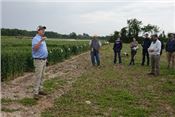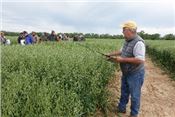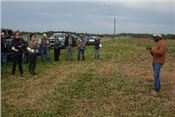Price, Disease Topics Of Wheat, Oat Field Day
JOHNNY MORGAN
WINNSBORO, LOUISIANA
Despite the chilly temperatures and occasional drizzle, grain crop producers and seedsmen heard the latest information about the cereal grains industry on April 20.
The annual wheat and oat field day held at the LSU AgCenter Macon Ridge Research Station in Winnsboro provided some great news – and some that was not so great.
The war in Ukraine has been the driving force behind the price of wheat nearly doubling in one year from $6 per bushel to $11, said AgCenter wheat breeder Steve Harrison.
Harrison discussed his wheat and oat variety trials located in Winnsboro and the collaborative effort between the seven Southern universities that make up the Southeastern University Grains, or SunGrains, small grain breeding and genetics group The group is spearheaded by the LSU AgCenter wheat program and is made up of the University of Arkansas, Clemson University, University of Florida, University of Georgia, North Carolina State University and Texas A&M University.
“We share a lot of resources and information between the universities,” Harrison said. “We release each other’s breeding lines that may do poorly in one state but do fine in another.”
Boyd Padgett, LSU AgCenter plant pathologist, said one of the goals for growers is to not have to make multiple applications of fungicide.
“There are mainly two types of diseases that are causing the most problems in wheat,” he said. “One is foliar, and the other is head blight or scab, which actually affects the head of the wheat plant.”
It’s difficult for the growers to avoid additional applications because the diseases occur during different growth stages.
“We do have a really good variety testing program that’s coordinated by Dr. Steve Harrison,” he said. “And we do evaluate those varieties for genetic resistance and against these different pathogens. We also conduct the variety trials with and without fungicide to allow growers to evaluate the return on fungicide investment.”
Padgett said wheat is grown throughout Louisiana, with the exception of the southeastern region.
AgCenter entomologist Tyler Towles discussed the major issues being faced by growers with young corn, cotton and soybeans.
“In cotton, we’re seeing some thrips, and in corn, there’s some cutworm pressure,” he said. “Another problem we’re seeing is damage from slugs.”
Towles said he’s looking at the differences in pyrethroids on rice stink bugs because they show up on wheat first and also have been showing some resistance in rice.
“We are also seeing a lot of slug damage in early-planted crops,” he said. “There is not much that can be done other than using bait, which is expensive. Replanting may be the only other option if damage is significant.”
AgCenter plant pathologist Trey Price said he works closely with Harrison to help in the development of resistance to disease in the wheat breeding program.
“We do a lot of work to try and screen varieties for scab resistance, which is a big problem in wheat,” he said. “We also rate a lot of the oat varieties for disease resistance too because a large part of a breeding program is breeding for disease resistance.”
Melissa Cater, AgCenter Northeast Region director, said the collaboration between the AgCenter plant scientists is a plus for producers around the state.
“Dr. Steve Harrison’s work with variety testing is very important to the industry,” she said. “He brings a big program that allows collaboration with our scientists here on the station.”
AgCenter soil fertility specialist Rasel Parvej said 2022 fertilization decisions – especially as they relate to phosphorus and potassium – will be critical to producers because of price increases.
“Based on our two-year study, we may need to revise our current phosphorus and potassium recommendations,” he said. “Depending on how deficient the soil is, producers can still produce profitable crops by applying around 50 percent to 80 percent of the recommended rates.”
Parvej advises growers to have their soil tested before applying fertilizer. He said growers should invest a little more money on soil testing rather than fertilizing without knowing if there will be a yield response to the added fertilizers.
AgCenter weed scientist Donnie Miller reported that updated cover crop seeding rate recommendations will be available to producers this summer.
“Additionally, research results indicated that a 1-pint -per-acre rate of a two-pound clethodim formulation, although slower in colder temperatures, was an effective alternative to glyphosate for termination of grass cover crops,” he said.
Miller also discussed the potential to utilize cereal rye as a cover crop in combination with residual herbicides applied after emergence as an effective management program for Italian ryegrass.
Graduate student Peters Egbedi also spoke about the benefits of double- cropping wheat with cotton or soybeans.
“For three years, our findings suggest a synergistic interaction in wheat-cotton rotation where the wheat utilizes the residual nitrogen applied to the cotton while the succeeding cotton plant obtains nutrients released from the decomposed wheat residues,” he said.
The field day was sponsored by Delta Grow, Louisiana Land Bank, AG South Genetics, Progeny and Stratton Seed Company and Dyna-Gro. ∆
JOHNNY MORGAN: LSU AgCenter

LSU AgCenter entomologist Tyler Towles discussed some of the major issues being facing growers with young corn, cotton and soybeans during the annual wheat and oat field day at the AgCenter Macon Ridge Research Station in Winnsboro on April 20.

LSU AgCenter wheat breeder Steve Harrison discusses his wheat variety trials at the annual wheat and oat field day at the AgCenter Macon Ridge Research Station in Winnsboro on April 20.

LSU AgCenter graduate student researcher Peters Egbedi speaks to producers about the benefits of double-cropping wheat with cotton or soybeans at the annual wheat and oat field day at the AgCenter Macon Ridge Research Station in Winnsboro on April 20.
Photos by Johnny Morgan/LSU AgCenter